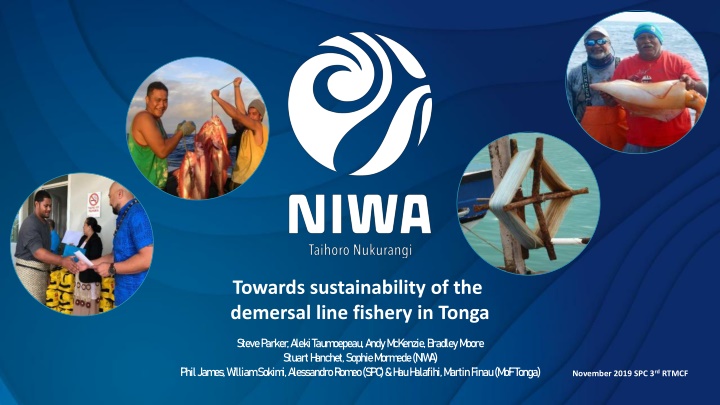
Sustainability Strategies for Tongan Demersal Line Fishery
In November 2019, a collaborative effort was made to enhance the sustainability of the demersal line fishery in Tonga. The project aimed to address the boom-and-bust cycles in catch through fishery diversification, improved governance, and marketing. Objectives included developing sustainable Total Allowable Catches (TACs) for deepwater snapper, implementing a robust fishery management plan, enhancing technical capacity, diversifying the fishery to alternative targets like deepwater squid, and promoting gender inclusivity in decision-making. Spatial population modeling and bioeconomic modeling were employed to guide management decisions. The project highlighted the importance of long-term conservation measures to protect the industry and the significance of diversification in ensuring sustainable fisheries.
Download Presentation

Please find below an Image/Link to download the presentation.
The content on the website is provided AS IS for your information and personal use only. It may not be sold, licensed, or shared on other websites without obtaining consent from the author. If you encounter any issues during the download, it is possible that the publisher has removed the file from their server.
You are allowed to download the files provided on this website for personal or commercial use, subject to the condition that they are used lawfully. All files are the property of their respective owners.
The content on the website is provided AS IS for your information and personal use only. It may not be sold, licensed, or shared on other websites without obtaining consent from the author.
E N D
Presentation Transcript
Towards sustainability of the demersal line fishery in Tonga Steve P arker, A leki Taum oepeau, A ndy M cK enzie, B radley M oore Stuart H anchet, Sophie M orm ede (N IW A ) Phil Jam es, W illiam Sokim i, A lessandro R om eo (SPC) & H au H alafihi, M artin Finau (M oF Tonga) November 2019 SPC 3rd RTMCF
Purpose The Tongan deepwater snapper fishery has had boom and bust cycles in catch Needed fishery diversification, improved governance, and marketing Science-based transition to self-sustaining fishery partnership between Tongan government and fishers Project implementation is by collaborative stakeholder meetings held in English & in Tongan Objectives Develop sustainable TACs for deepwater snapper complex Develop a science informed robust fishery management plan Improve technical capacity in-country for monitoring and analysis Diversify the fishery to alternative targets (e.g. baitfish) Include women in decision making and economic development
Spatial population modelling Snapper complex spread throughout Tongan EEZ on seamounts and banks Biomass dynamic models for catch limits SPM software uses CPUE and size composition data used to develop spatial model of where population resides And where small fish are likely to be found (to avoid) Enable spatial management Catch rate per cell
Bioeconomic modelling 15 year outlook More conservative TACs should be considered to better protect the industry Vessel limits should be considered at about 15 vessels Without management measures the gains from the NZAid project would be wiped out within 10 to 15 years Value Updated modelling underway now to look at the effect of diversification and recent data on CPUE and number of vessels Number of vessels
Diversification: deepwater squid Constraints on snapper catch require alternative targets 2 species - Diamondback 18 25 kg and Neon flying squid 10kg Target market: Domestic - local restaurants, local sales, potential fish bait Challenge to develop new market for a new species
Diversification: Baitfish Coastal little fuel cost Anchovies, sardines, sardinella, flying fish Domestic market bait, but also local sales Light attraction to lift nets Hand wind reels for loligo squid
Cross cutting themes Gender inclusion Gender inclusion Support involvement of women in fisheries and improve infrastructure for fish to reach both domestic and international markets Women s group particularly organized, forward thinking, and very productive, especially with diversification initiatives Capacity building Capacity building Staff upskilled through regular (3-monthly) training courses in R Tonga MoF staff attachments to NIWA for specialised training in stock assessment Training on catch sampling and data recording Training on otolith processing and age reading
Stakeholder engagement Using science to bring industry and government together Flexible contract structure Needs (and changes to needs) identified by industry and government Measurable outcomes in economics, safety, training, sustainability, compliance
Acknowledgments Thanks to our partners on the Project Management Group including the Tonga Ministry of Fisheries, SPC and the Tongan National Fisheries Council Tonga National Fisheries Council Thanks also to the Ministry of Foreign Affairs and Trade NZAid Partnership programme for funding the project
